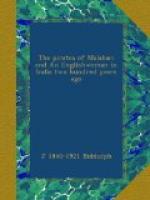Considerable anxiety was caused in Bombay, at this time, by the appearance of three French men-of-war cruising on the coast, with the evident intention of waylaying the Company’s ships from Europe. One of them was a fifty-gun ship, and there was nothing in Bombay harbour to cope with her. To meet the difficulty, a large number of fishing-boats were sent out, each with an English sailor on board, to creep along the coast and warn all incoming ships. In spite of these precautions, the Anson missed the boats sent to warn her, and was attacked by the French Apollo and Anglesea within sight of the harbour. Captain Foulis defended himself long enough to enable him to send off the dispatches and treasure he carried, in his boats, before he was forced to surrender.[2] The Directors bestowed on him a gratuity of L400 for his able conduct.
Fortunately for Bombay, Toolajee Angria’s energies were at this time directed against Canara, where in two successive expeditions he sacked Mangalore and Honore, carrying off a large booty.
In October, 1749, Toolajee, who for some time had been giving little trouble, inflicted a severe loss on the Bombay marine. The Restoration was the most efficient ship at the Council’s disposal. It had been commanded by Captain Hough, a bold and resolute man, who had done good service in her, attacking Angria’s ships and chasing them into their fortified harbours. She carried seventy-five European seamen, sixteen lascars, and thirty soldiers—unruly fellows who wanted a firm hand over them. Hough had fallen ill, and the command was given to Captain Thomas Leake, an irresolute man, not fitted to command such, a crew. They very soon fell into disorder. While coming up the coast from Goa they were attacked by Toolajee’s fleet of five grabs, accompanied by a swarm of gallivats. From noon till dark the Restoration was surrounded and cannonaded. Her guns were so badly served that they inflicted little or no damage, while her own sails and rigging were badly cut about. During the night, the action was fitfully continued, her ammunition being lavishly and uselessly expended. Toolajee himself was present, and had a number of European gunners with him. At noon the next day his grabs edged down again, fell aboard the Restoration, and boarded. On this, the colours were struck, Leake ran below, an example that was followed by his crew, and the ship was taken. When they were released, some months afterwards, the Council, after due inquiry, decided that Leake and his officers should not serve the Company again till the Directors’ pleasure was known.
Meanwhile, the Coolees of Guzerat had become very troublesome. In 1749, they captured a Bengal ship with Rs.60,000 in hard cash on board, and a cargo of nearly equal value. Their depredations continuing, the Dutch proposed joint action against them; so, in December, 1750, a joint Dutch and English squadron forced the defences of the Coorla River, burnt and captured twenty-three of their vessels, and reduced them to quietness for a time.




